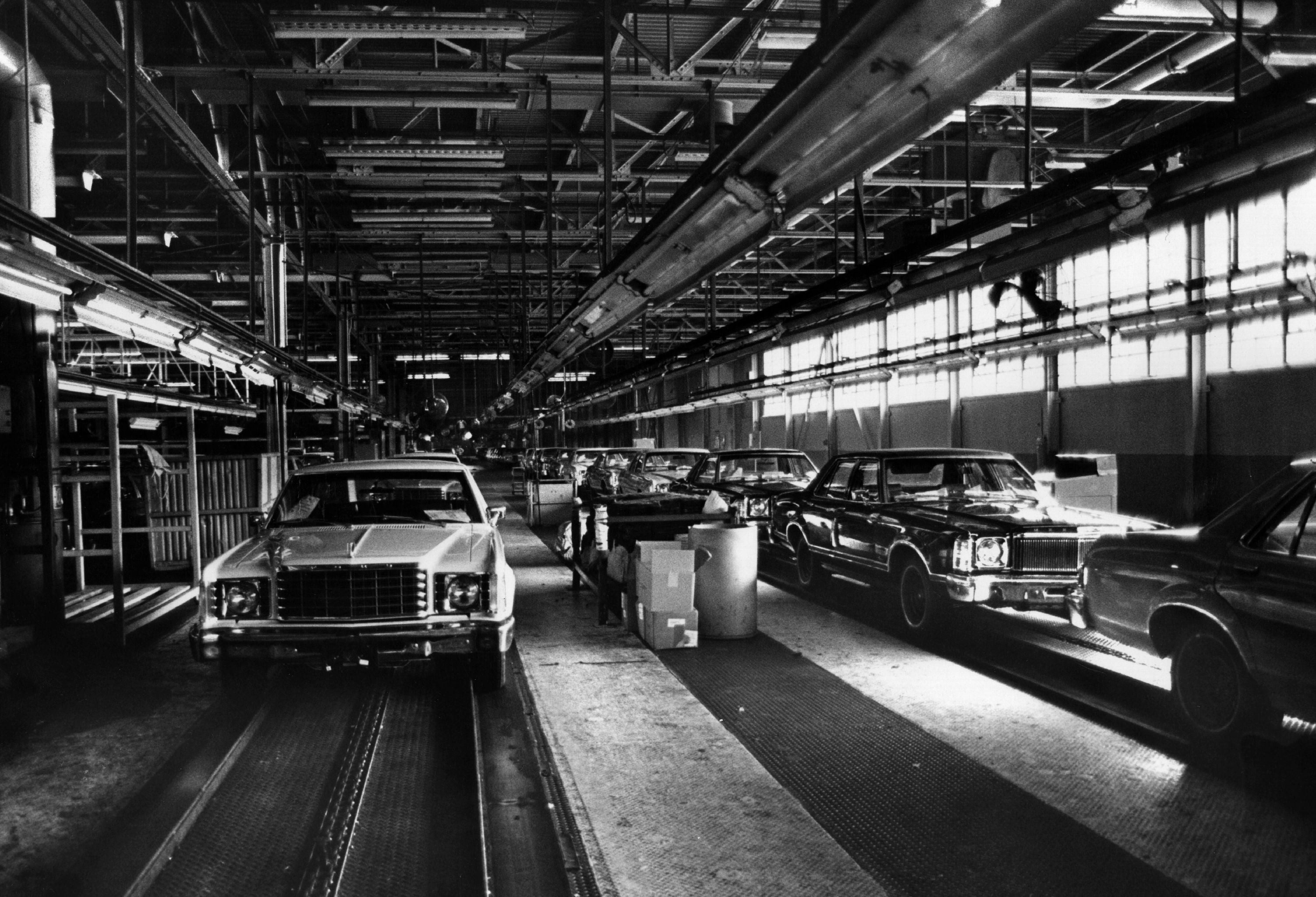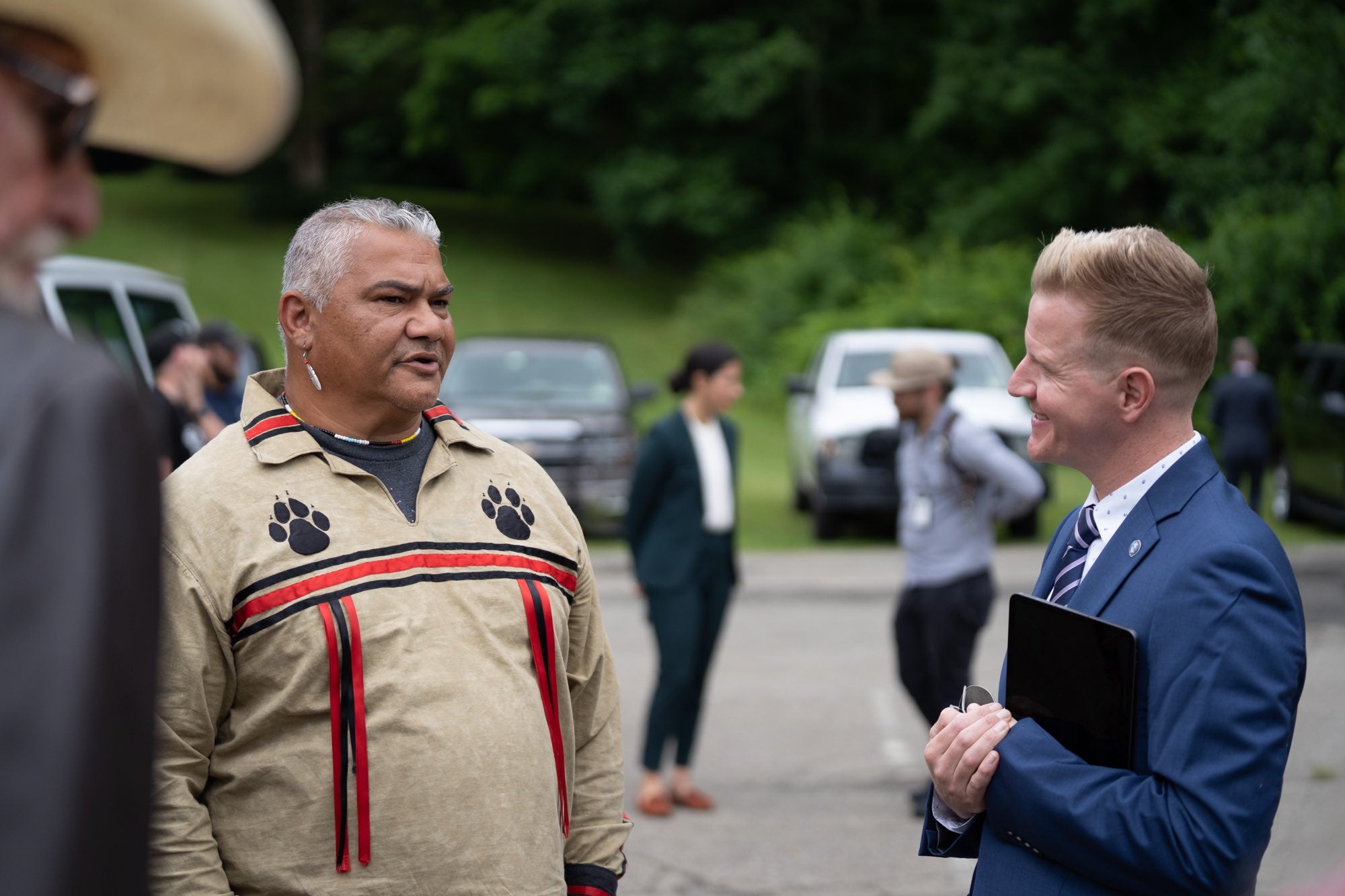‘Cancer road’: A Ford factory dumped toxic sludge on tribal land. Years later, it’s still making people sick
A lawsuit filed by New Jersey will attempt to hold Ford accountable for decades of environmental damage to native lands. Richard Hall talks to the residents still fighting for justice.


When Angel Stefancik was a kid, she would often play in the dirt. A lot of kids do the same, but the dirt in the hills around her home in Upper Ringwood — a close-knit working-class neighbourhood in the shadow of the Ramapough Mountains in New Jersey — was special. It was often bright and multicoloured, it glistened in the sun and had a particular scent.
“We would be out here all hours, day and night. We made mud pies, played chef, that kind of thing,” says Stefancik, now 22-years-old. “We had nowhere else to play.”
Those streaks of colour in the soil came from thousands of tonnes of leftover paint that was dumped decades ago by the Ford motor company. It was brought by truck from the company’s giant factory in Mahwah just down the road and disposed of in the abandoned Ringwood mines.
The residents of Ringwood knew where the paint came from, but they didn’t know the impact it would have until years later, when many of them began to fall ill. They petitioned for years to local authorities to clean up the mess, to no avail.
In 2005, a months-long investigation by The Record of New Jersey titled “Toxic Legacy” found high levels of toxic chemicals in the paint sludge that still littered the area. Following public pressure, the Environmental Protection Agency oversaw several more investigations into how much of the paint remained and what it contained. The investigations confirmed what locals had known for years: it was toxic, poisonous, and it was everywhere.
“That’s when everyone started connecting the dots,” Stefancik says.

The toxic sludge in which Stefancik, her friends and family had all played, contained a plethora of deadly chemicals: lead, arsenic, benzene, polychlorinated biphenyls (PCBs), semi-volatile organic compounds, chrysene and 1,4 dioxane, to name a few. These chemicals were the likely cause of the chronic health conditions suffered by almost everyone she knew. One street in the area where she lives was dubbed “cancer road” because nearly every household on it has been touched by the disease.
The pollution was not just hazardous to their health, but their very way of life. The Ringwood Mines area is the historic homeland of the Ramapough Lenape Nation Turtle Clan, a Native American tribe to which Stefancik belongs. For generations they hunted, fished, foraged, and farmed in the area — the degradation of their ancestral homes was an attack on their culture, too.
Despite years of activism, several more clean up efforts, an HBO documentary and a meager financial settlement struck with Ford at the height of the financial crisis, the residents of Upper Ringwood have never had closure.
Now, a major new lawsuit seeks to hold Ford accountable for decades of environmental damage. The complaint, filed by New Jersey’s Department of Environmental Protection, accuses the company of “willful and wanton discharge of hazardous substances and pollutants into the environment.” Filed in June, it seeks compensation for lost natural resources, as well as punitive damages and penalties for Ford’s ongoing “concealment of the full extent of the contamination.”
For the state of New Jersey, it is a chance for its leaders to show they are serious about environmental protection and repair the damage caused by its own failures. For Stefancik and her neighbours, it is just the latest episode in a long-running saga that has played out over several generations here in Ringwood.
Ford declined a request to respond to this story from The Independent.
The largest auto plant in the world
When it opened in 1955, the Ford auto plant in Mahwah was the largest car factory in the United States. It was the size of seven football fields and employed thousands of workers until its closure in 1980. So significant was it to New Jersey that Bruce Springsteen sang about its demise in the 1982 song ‘Johnny 99.’
Millions of cars were built on the Mahwah assembly line. They passed through a long hall where gleaming steel bodies would be sprayed with brightly coloured paint — Candy Apple Red, Calypso Coral, New Lime. Run-off from that spray would drip down through a steel grate, into large containers, and then onto trucks heading to Upper Ringwood.
Their final destination was the Ringwood Mines — a series of now unused mine shafts and tunnels bought by Ford specifically for use as landfill. Stefancik’s parents would watch the trucks go by their house. They knew something wasn’t right even back then, but they didn’t have the full story.
“They knew that they were dumping something but just didn’t have the slightest clue what it was,” she says. “My mom, my dad, my grandparents, people were playing this stuff for years and nobody really understood what it was.”
Ford closed its Mahwah plant in 1980. Two years later, regulators found arsenic in the water supply, which led to the Environmental Protection Agency (EPA) marking the area for clean up under the Superfund programme — a trust fund set up by Congress to handle the country’s most polluted and hazardous waste sites needing long-term cleanup. Ford, under the EPA’s supervision, spent five years cleaning nearly 500-acres of land. In 1994, the EPA removed the area as a Superfund site, clearing that “no further cleanup by responsible parties is appropriate.”
The very agencies that were supposed to protect the public from harmful environmental damage told the residents of Ringwood that the matter was closed.
In the years after Ford closed its factory, the company either donated or sold all of its contaminated properties while fully aware that the land was contaminated with toxic material, according to the lawsuit.
It wasn’t until 2007, thirteen years later, that the EPA was forced to reverse that decision.

Men in white suits
Stefancik was just six years old when the men in white suits turned up. She watched from the front porch of her home as the black cars sped by on their way up the road. Her family and neighbours all rushed out to follow these strange figures up the road. People were shouting.
“You ever watched those movies when the aliens crash to earth and those people are out there with those detector things, like ET? That’s what it was like,” says Stefancik.
“There were these big tall men in white suits and people standing there on radios — it freaked us out. We were scared. We were like, what the hell? We were all asking questions and nobody would answer them,” says Stefancik.
She didn’t know it then, but Stefancik was watching history unfold. For the first time ever, the Environmental Protection Agency was in the process of re-designating a site for Superfund status — a site that was already declared safe and clean. The decision came after an investigation by The Record newspaper found dangerous toxic paint was still present even years after it was declared safe, prompting further tests.
The designation sparked a second clean-up at the site. Between 2004 and 2019, Ford removed “an additional 53,528 tons of paint sludge, drum remnants, and associated soil from Ringwood Mines,” according to New Jersey’s DEP complaint.
But it still wasn’t enough.
“Nonetheless, the natural resources of Ringwood Mines remain contaminated with hazardous substances due to Ford’s dumping and discharging at the Site,” the complaint adds.
The designation was also the catalyst for the first major lawsuit relating to the pollution. Some 600 residents sued Ford in a state court in 2006 for property damage and personal injuries from the toxic paint sludge that plagued the area. Residents said the toxins in the paint were the cause of cancers and skin diseases that were rife in the area.
The legal battle was filmed for an HBO documentary called Mann v. Ford, which was released in 2011. Ford eventually settled for $10mn, while admitting no liability for the residents’ claims of health problems caused by the waste.
For many, though, it was too little, too late. Stefancik was 10 when the legal battle started, and 18 when the settlement came through. She was awarded $25,000 originally, but ended up with something closer to $18,000.
“The money did help some people fix their homes and pay for their medical bills, but then there were people who... the money couldn’t fix the damage that’s been done,” she says.
Stefancik was one of those people.
“I’m 22 years old and I have a list of health issues that you could write a book about. I have really bad asthma. I have a skin problem. I have irritable bowel syndrome. I have chronic constipation on top of those three. I have it also has affected me in my mental health issues as well. I suffer with depression, anxiety, bipolar disorder, post-traumatic stress disorder,” she says.
Proving a link between pollution and disease is notoriously difficult, and the lawsuit settled Ford’s non-liability on the matter. Nevertheless, for Stefancik and other members of the Turtle Clan, there was a sense that no one had been held accountable for the damage done to their lives.
“There’s a lot of factors that bleed into everything — the harassment, the neglect of our people, like we were pushed to the side. And it traumatised a lot of us, especially my generation. We grew up where we couldn’t be friends with certain people because of where we’re from and just hurtful, hurtful things,” she says.
A new lawsuit
There was plenty of blame to go around for the decades of successive failures that allowed Ford’s toxic paint to remain in Upper Ringwood for so long. Ford may have dumped the sludge, but local authorities allowed it. The EPA declared the site safe once, despite the ground being soaked in poisonous paint. There is even criticism for the lawyers who won the settlement for Ringwood’s residents.
So the question remains: why were the people of Ringwood failed by so many, for so long?
Vincent Mann, chief of the Ramapough Lenape Nation Turtle Clan, believes the answer to that question requires looking back not decades, but centuries. Since the Europeans first made contact with Native Americans, he says, the environment in which the Ramapough people lived has been consistently degraded by outside forces.
“The big Tulip trees were taken away so we couldn’t make our canoes anymore. Where there were ponds, there are no more. Where there were little brooks, now are ponds. The native Brook Trout stream that was once there is no longer there. We can’t eat the wild carrots, we can’t collect the wild medicinals, we can’t eat from the apple trees. Things like that were taken away,” he says. “And this didn’t start in 1974, this started in the 1700s.”
Chief Mann has been an active campaigner for environmental justice for most of his life. Much of his efforts have been aimed at winning justice for people in his own community who suffered as a result of Ford’s pollution. He says the Ramapough people worked the very mines that brought so much prosperity to the United States in the early 20th century.
“The Munsee-speaking people who were able to reside here, we worked in those mines, along with Dutch people, German people, Italian people. Every war from the Revolutionary War, World War I, and then it was prepped for World War II — those mines were used to produce steel. Even the steel that holds the dome over the Capitol building in Washington, our people were all part of that,” he says.
Speaking to The Independent at the organic farm he now runs around 30 miles from Ringwood, he says the failures did not stop when Ford left.
“Everyone is responsible for the death and destruction of our community. Everyone, because everybody knew the truth, yet they didn’t take the proper action,” he says.
Chief Mann likened the EPA’s decision in 1994 to declare the site clean to a “death sentence” for his people, and there was a general lack of concern for decades from everyone, including environmental inspectors, Ford company representatives and even local officials, he adds.
“To allow that stuff to happen to the citizens of that town, the only way that that would take place is, unfortunately, that they were racist people,” he says, “that they thought less of us than themselves.”
Chief Mann says he can point to a clear example of how his people were treated differently from other communities who faced similar environmental damage. When residents of the community of Love Canal in Niagara Falls, New York, were found to have suffered illnesses caused by chemicals that had seeped through the groundwater into their homes, president Jimmy Carter declared a state of emergency in 1978 and had the federal government relocate 239 families. He did the same in 1981 to relocate the remaining 700 families after a campaign that demonstrated they too were at risk.
“It was a presidential order by Jimmy Carter that cleared the red tape to save people’s lives,” says Chief Mann. “But guess what? Those people weren’t us, right? They weren’t us. They weren’t the Ramapoughs,” he says. “They were the descendants of European settlers. That’s who they were. And the president of the United States stood up and demanded that those people’s lives be saved.”
Some of that distrust of local authorities and regulators who were supposed to protect the people of Upper Ringwood lasts to this day.
This latest lawsuit against Ford, filed by New Jersey’s Department of Environmental Protection, hopes to repair some of that mistrust, and is part of what the state’s acting attorney general Matthew J. Platkin says is a more aggressive approach to dealing with polluters.
The damages sought by New Jersey in this most recent lawsuit are unrelated to a state-federal settlement in 2019 in which Ford agreed to pay the state $2.1 million to cover its past costs for cleanup of the paint sludge.
Any money won from this legal action would be used to fix the environmental damage caused by the pollution and compensate the public for the loss of those resources.
At the press conference to announce the lawsuit back in June, Mr Platkin said the state planned to hold Ford accountable “for knowingly polluting some of the State’s most precious environmental assets, then walking away without disclosing the toxic mess they had made or attempting to mitigate the harm.”
Speaking at that same press conference, Chief Mann thanked the state for taking action, but added: “If we could pick you up and throw you, that would actually be as far as we could put our trust into you at this time.”

That distrust is shared by environmental campaigners. Robert Spiegel, the founder of the nonprofit Edison Wetlands Association, which helps local communities deal with the fallout from pollution, has been working with the residents of Upper Ringwood for more than a decade.
“It really is a failure of government at all levels,” he tells The Independent. “It’s a failure of local government. It’s a failure of the regulatory agencies, whose actual job it was to protect the residents against an entity like Ford, and it’s a failure to address most, if not all, of the public health threats at Ringwood.”
“The community was essentially poisoned, wholesale poisoned… and these government entities and these regulators knew what was going on and they did nothing,” he adds.
But there may be a glimmer of hope, according to Spiegel. The bipartisan infrastructure bill passed by the Biden administration last year awarded $1bn in funding and reinstated taxes on chemical companies to finance Superfund cleanups. That will give the EPA the funds to make use of a law that allows them to clean up Superfund sites and bill the responsible company afterwards.
Spiegel says the bill will help “do work that needs to be done without having to ask the taxpayers to foot the bill.”
Beyond the cleanup efforts, and the government accountability, Spiegel believes Ford owes the people of Upper Ringwood something else. He suggests that Andy Hobbs, the vice president of Ford Motor Company, apologise “publicly to this indigenous community for poisoning their community” and letting it continue.
“Start apologising for what the corporation did to this community and then doing what needs to be done to clean it up, address the health impact on the community, provide services so that they can get what they need and help them to move forward with their lives,” he adds.
Stefancik feels like she has been here many times before.
“All these years I’ve lived in this town, I’ve had many government officials stand in front of me and tell me you’ll be able to have the future you want, your kids will be healthy, you’ll be healthy. I’m not gonna lie to you, I don’t believe it, because they do this every time,” she says. “We’re another statistic to them.”
“It’s not fair to people like us, and in Flint, Michigan, and all these other places that are suffering because of these people. It’s not fair. We all deserve a piece of land where you can pick up your dirt and touch it. We all deserve to be able to survive.”
Her biggest wish for this lawsuit is just for Ford to account for what it did.
“Take responsibility. That’s all I ask,” she says.
Join our commenting forum
Join thought-provoking conversations, follow other Independent readers and see their replies
Comments
Bookmark popover
Removed from bookmarks